pipeline,Handler, HandlerContext创建源码剖析
源码解析目标
- Netty中的ChannelPipeline,ChannelHandler和ChannelHandlerContext是核心组件,从源码解析来分析
- Netty是如何设计三个核心组件
- 分析Netty是如何创建和协调三个组件
- 三个组件的结构关系是什么样的
Pipeline 接口设计
- 如下源码,类结构
extends ChannelInboundInvoker, ChannelOutboundInvoker, Iterable<Entry<String, ChannelHandler>> {}


- 可以从源码中看到,ChannelPipeline是一个接口并且继承了inBound,outBound,Iterable接口,它提供了各种addFirst,addLast等类似操作链表的方法,能够多类似链表的结构进行插入,追加,删除,替换操作,同时他的返回值包括ChannelPipeline,或者ChannelHandler或者ChannelHandlerContext
- 我们看如下某个方法
/**
* Inserts a {@link ChannelHandler} at the first position of this pipeline.
*
* @param name the name of the handler to insert first
* @param handler the handler to insert first
*
* @throws IllegalArgumentException
* if there's an entry with the same name already in the pipeline
* @throws NullPointerException
* if the specified handler is {@code null}
*/
ChannelPipeline addFirst(String name, ChannelHandler handler);
- 以上方法是增加链表头节点方法,参数是一个那么,和关键的参数ChannelHandler,说明ChannelPipeline类似链表的结构中封装是一个一个的Handler,继续找源码中的注释查看如下
- 一下是ChannelPipeline 源码中的一个说明图
* <pre>
* I/O Request
* via {@link Channel} or
* {@link ChannelHandlerContext}
* |
* +---------------------------------------------------+---------------+
* | ChannelPipeline | |
* | \|/ |
* | +---------------------+ +-----------+----------+ |
* | | Inbound Handler N | | Outbound Handler 1 | |
* | +----------+----------+ +-----------+----------+ |
* | /|\ | |
* | | \|/ |
* | +----------+----------+ +-----------+----------+ |
* | | Inbound Handler N-1 | | Outbound Handler 2 | |
* | +----------+----------+ +-----------+----------+ |
* | /|\ . |
* | . . |
* | ChannelHandlerContext.fireIN_EVT() ChannelHandlerContext.OUT_EVT()|
* | [ method call] [method call] |
* | . . |
* | . \|/ |
* | +----------+----------+ +-----------+----------+ |
* | | Inbound Handler 2 | | Outbound Handler M-1 | |
* | +----------+----------+ +-----------+----------+ |
* | /|\ | |
* | | \|/ |
* | +----------+----------+ +-----------+----------+ |
* | | Inbound Handler 1 | | Outbound Handler M | |
* | +----------+----------+ +-----------+----------+ |
* | /|\ | |
* +---------------+-----------------------------------+---------------+
* | \|/
* +---------------+-----------------------------------+---------------+
* | | | |
* | [ Socket.read() ] [ Socket.write() ] |
* | |
* | Netty Internal I/O Threads (Transport Implementation) |
* +-------------------------------------------------------------------+
* </pre>
- 入上图所示,表示的是一个handler的list,handler用于处理入站或者出站的事件,其中inBound是入站,方向是从Socket到ChannelPipeline。 outBound是出站方向是从ChannelPipeline到Socket,ChannelPipeline实现了一个过滤器模式,方便用户控制事件的处理,以及控制handler在pipeline中的交互
- 接着看如下源码
* Converts this pipeline into an ordered {@link Map} whose keys are
* handler names and whose values are handlers.
*/
Map<String, ChannelHandler> toMap();
......
@Override
ChannelPipeline fireChannelRead(Object msg);
......
- 以上源码中注释意思:将pipeline中的Handler 利用name:Handler的方式放入有序的Map中,并且提供以下方法进行处理
- 因此ChannelPipeline会通过fireChannelRead等类似fireXXX的方法来控制ChannelPipeline中的Handler来处理入站和出站事件
- 我们也知道,一个Pipeline中通常会有多个Handler,比如,一个典型的服务器在每个通道的管道中都有以下几个步骤处理
- 处理程序协议解码器–将二进制数据转换为java对象
- 协议编码器–将java对象转换为二进制数据
- 业务逻辑处理器–执行具体的业务逻辑(安具体需求类似入库等)
- 以上第三步骤中的业务逻辑处理程序我们尽量做到不会将线程阻塞,因为此处阻塞必然引起IO速度,进而影响整个Netty程序性能。如果业务程序很快,可以放IO线程中,反之需要异步执行,ChannelHandler对象中给我们提供了线程池用来异步执行
- 接下来我们先来分析ChannelPipeline初始化的源码,依此来理解ChannelPipeline的实现以及对应的数据结构
- 用以下案例来分析源码
public final class EchoClient {
static final boolean SSL = System.getProperty("ssl") != null;
static final String HOST = System.getProperty("host", "127.0.0.1");
static final int PORT = Integer.parseInt(System.getProperty("port", "8007"));
static final int SIZE = Integer.parseInt(System.getProperty("size", "256"));
public static void main(String[] args) throws Exception {
// Configure SSL.git
final SslContext sslCtx;
if (SSL) {
sslCtx = SslContextBuilder.forClient()
.trustManager(InsecureTrustManagerFactory.INSTANCE).build();
} else {
sslCtx = null;
}
// Configure the client.
EventLoopGroup group = new NioEventLoopGroup();
try {
Bootstrap b = new Bootstrap();
b.group(group)
.channel(NioSocketChannel.class)
.option(ChannelOption.TCP_NODELAY, true)
.handler(new ChannelInitializer<SocketChannel>() {
@Override
public void initChannel(SocketChannel ch) throws Exception {
ChannelPipeline p = ch.pipeline();
if (sslCtx != null) {
p.addLast(sslCtx.newHandler(ch.alloc(), HOST, PORT));
}
//p.addLast(new LoggingHandler(LogLevel.INFO));
p.addLast(new EchoClientHandler());
}
});
// Start the client.
ChannelFuture f = b.connect(HOST, PORT).sync();
// Wait until the connection is closed.
f.channel().closeFuture().sync();
} finally {
// Shut down the event loop to terminate all threads.
group.shutdownGracefully();
}
}
}
public class EchoClientHandler extends ChannelInboundHandlerAdapter {
private final ByteBuf firstMessage;
/**
* Creates a client-side handler.
*/
public EchoClientHandler() {
firstMessage = Unpooled.buffer(EchoClient.SIZE);
for (int i = 0; i < firstMessage.capacity(); i ++) {
firstMessage.writeByte((byte) i);
}
}
@Override
public void channelActive(ChannelHandlerContext ctx) {
ctx.writeAndFlush(firstMessage);
}
@Override
public void channelRead(ChannelHandlerContext ctx, Object msg) {
ctx.write(msg);
}
@Override
public void channelReadComplete(ChannelHandlerContext ctx) {
ctx.flush();
}
@Override
public void exceptionCaught(ChannelHandlerContext ctx, Throwable cause) {
// Close the connection when an exception is raised.
cause.printStackTrace();
ctx.close();
}
}
public final class EchoServer {
static final boolean SSL = System.getProperty("ssl") != null;
static final int PORT = Integer.parseInt(System.getProperty("port", "8007"));
public static void main(String[] args) throws Exception {
// Configure SSL.
final SslContext sslCtx;
if (SSL) {
SelfSignedCertificate ssc = new SelfSignedCertificate();
sslCtx = SslContextBuilder.forServer(ssc.certificate(), ssc.privateKey()).build();
} else {
sslCtx = null;
}
// Configure the server.
EventLoopGroup bossGroup = new NioEventLoopGroup(1);
EventLoopGroup workerGroup = new NioEventLoopGroup();
try {
ServerBootstrap b = new ServerBootstrap();
b.group(bossGroup, workerGroup)
.channel(NioServerSocketChannel.class)
.option(ChannelOption.SO_BACKLOG, 100)
.handler(new LoggingHandler(LogLevel.INFO))
.childHandler(new ChannelInitializer<SocketChannel>() {
@Override
public void initChannel(SocketChannel ch) throws Exception {
ChannelPipeline p = ch.pipeline();
if (sslCtx != null) {
p.addLast(sslCtx.newHandler(ch.alloc()));
}
//p.addLast(new LoggingHandler(LogLevel.INFO));
p.addLast(new EchoServerHandler());
}
});
// Start the server.
ChannelFuture f = b.bind(PORT).sync();
// Wait until the server socket is closed.
f.channel().closeFuture().sync();
} finally {
// Shut down all event loops to terminate all threads.
bossGroup.shutdownGracefully();
workerGroup.shutdownGracefully();
}
}
}
@Sharable
public class EchoServerHandler extends ChannelInboundHandlerAdapter {
@Override
public void channelRead(ChannelHandlerContext ctx, Object msg) {
ctx.write(msg);
}
@Override
public void channelReadComplete(ChannelHandlerContext ctx) {
ctx.flush();
}
@Override
public void exceptionCaught(ChannelHandlerContext ctx, Throwable cause) {
// Close the connection when an exception is raised.
cause.printStackTrace();
ctx.close();
}
}
- 我们在上一篇Netty启动流程源码剖析中对ServerBootStrap进行过分析,其中说明ServerBootstrap 对象,他是一个引导类,用于启动服务器和引导整个程序的初始化。此处我们需要看Pipeline的创建过程,那么我们从此处来进行切入点。
- 同时要看ChannelPipeline的初始化代码我们将入口锁定在ChannelPipeline的操作上,在NettyServer的以下语句上加上断点
b.group(bossGroup, workerGroup)
.channel(NioServerSocketChannel.class)
.option(ChannelOption.SO_BACKLOG, 100)
.handler(new LoggingHandler(LogLevel.INFO))
.childHandler(new ChannelInitializer<SocketChannel>() {
@Override
public void initChannel(SocketChannel ch) throws Exception {
ChannelPipeline p = ch.pipeline();
if (sslCtx != null) {
p.addLast(sslCtx.newHandler(ch.alloc()));
}
//p.addLast(new LoggingHandler(LogLevel.INFO));
p.addLast(new EchoServerHandler());
}
});
- 启动NettyServer进行Debug,进入到 channel(NioServerSocketChannel.class) ,此处会进入到AbstractBootstrap的channel方法如下
/**
* The {@link Class} which is used to create {@link Channel} instances from.
* You either use this or {@link #channelFactory(io.netty.channel.ChannelFactory)} if your
* {@link Channel} implementation has no no-args constructor.
*/
public B channel(Class<? extends C> channelClass) {
if (channelClass == null) {
throw new NullPointerException("channelClass");
}
return channelFactory(new ReflectiveChannelFactory<C>(channelClass));
}
- 之前文章中分析过,这个一个通过反射获取channelClass的方法,我们传入的参数是NioServerSockerChannel。我们直接进入到NioServerSockerChannel的构造方法中。
public NioServerSocketChannel(ServerSocketChannel channel) {
super(null, channel, SelectionKey.OP_ACCEPT);
config = new NioServerSocketChannelConfig(this, javaChannel().socket());
}
//一直从super进去
protected AbstractChannel(Channel parent) {
this.parent = parent;
id = newId();
unsafe = newUnsafe();
pipeline = newChannelPipeline();
}
- 以上重点看newChannelPipeline方法,此处是创建ChannelPipeline的关键方法,进入后来到AbstractChannel的NewChannelPipeline方法中
protected DefaultChannelPipeline newChannelPipeline() {
return new DefaultChannelPipeline(this);
}
//最终的ChannelPipeline构造方法
protected DefaultChannelPipeline(Channel channel) {
this.channel = ObjectUtil.checkNotNull(channel, "channel");
succeededFuture = new SucceededChannelFuture(channel, null);
voidPromise = new VoidChannelPromise(channel, true);
tail = new TailContext(this);
head = new HeadContext(this);
head.next = tail;
tail.prev = head;
}
- 如上构造方法中是DefaultChannelPipeline,他是ChannelPipeline的一个抽象子类如下结构图
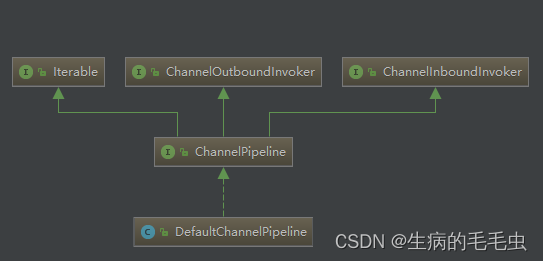
- 如上代码中参数是我们传入的NioServerSockerChannel
- 方法首先对channel参数进行初始化 this.channel = ObjectUtil.checkNotNull(channel, “channel”);用于pipeline操作channel
- 创建一个future和promise用于异步回调
- 创建一个inBound的tailContext,创建一个即是inbound又是outbound类型的headContext
- 接着讲两个Context相互连接形成双向链表
ChannelHandler 作用以及设计
public interface ChannelHandler {
/**
* 当把 ChannelHandler 添加到 pipeline 时被调用
*/
void handlerAdded(ChannelHandlerContext ctx) throws Exception;
/**
* 当从 pipeline 中移除时调用
*/
void handlerRemoved(ChannelHandlerContext ctx) throws Exception;
/**
* 当处理过程中在 pipeline 发生异常时调用
*/
@Deprecated
void exceptionCaught(ChannelHandlerContext ctx, Throwable cause) throws Exception;
@Inherited
@Documented
@Target(ElementType.TYPE)
@Retention(RetentionPolicy.RUNTIME)
@interface Sharable {
// no value
}
}
- ChannelHandler是一个接口,从提供的方法中可以看出,作用就是处理IO事件或者拦截IO事件,Handler处理事件时候分为入站和出站,两个方向的操作都是不同的,因此Netty定义了两个子接口继承ChannelHandler
- ChannelInboundHandler 入站事件接口
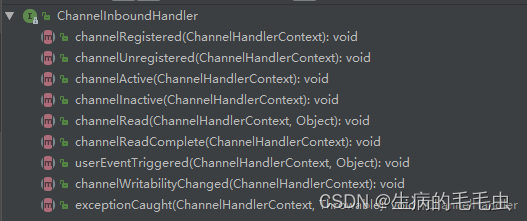
-
其中ChannelActive用户当Channel处于活动状态时候被调用
-
channelRead当从channel读取数据时候被调用,这两个方法是我们使用Netty编码的时候经常用到的
-
ChannelOutboundHandler 出站事件
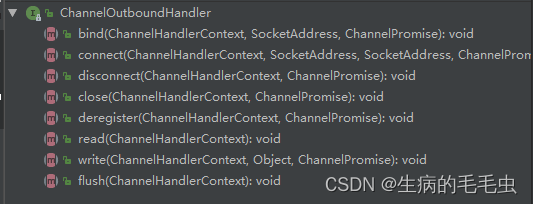
-
bind方法,当请求将channel绑定到本地的时候调用
-
close方法,当请求关闭Channel时候调用
-
ChannelDuplexHandler处理入站和出站事件
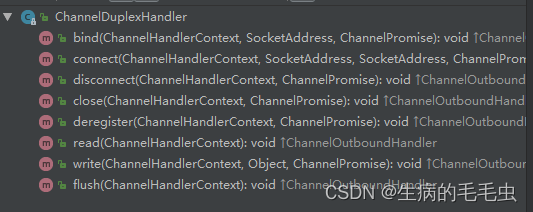
-
ChannelDuplexHandler间接实现了入站接口并直接实现了出站接口
-
是一个通用的能够同时处理入站事件和出站事件的类,类结构如下
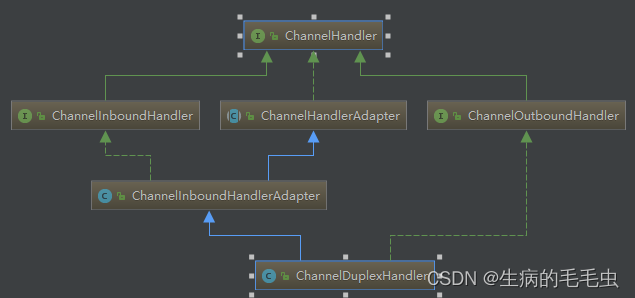
ChannelHandlerContext 作用以及设计
- 如下类结构图

- ChannelHandlerContext基础了出站方法,调用接口和入站方法调用接口,部分方法列表如下:
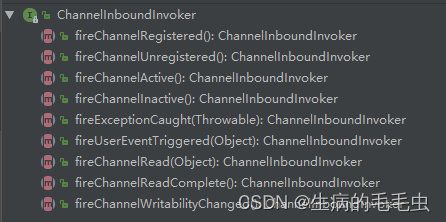
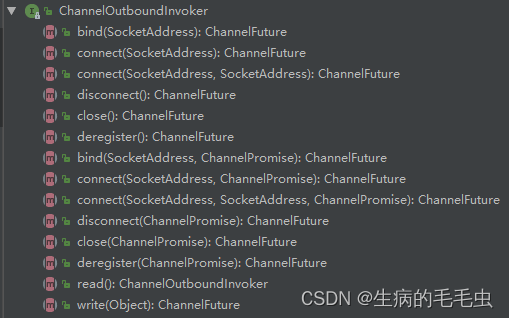
- ChannelHandlerContext不仅仅基础了inboud和outbound方法,同时也定义了一些自己的方法,channel,executor,handler,pipeline,分配内存器,管理handler是否被删除
- context是包装了handler相关的一切,方便Context可以在pipeline下进行操作handler
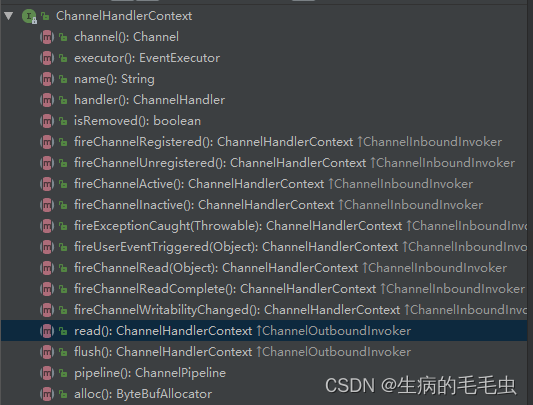
ChannelPipeline | ChannelHandler | ChannelHandlerContext
- 以上分析了三个核心对象的结构,接下来我们来看下三者的联系
- 我们知道,每个ChannelSocker的创建同时都有一个管道pipeline,我们调用pipeline的add方法添加handler,如下代码
socketChannel.pipeline().addLast(new NettyServerSchedulerReadHandler());
- 刚才解析ChannelPipeline的时候分析了pipeline方法,接着分析DefaultChannelPipeline中的构造方法,
protected DefaultChannelPipeline(Channel channel) {
this.channel = ObjectUtil.checkNotNull(channel, "channel");
succeededFuture = new SucceededChannelFuture(channel, null);
voidPromise = new VoidChannelPromise(channel, true);
tail = new TailContext(this);
head = new HeadContext(this);
head.next = tail;
tail.prev = head;
}
- 在初始化tail和 head 链表节点的时候,他创建的是一个TailContext, HeadContext,继续进去看Context的初始化
AbstractChannelHandlerContext(DefaultChannelPipeline pipeline, EventExecutor executor, String name,
boolean inbound, boolean outbound) {
this.name = ObjectUtil.checkNotNull(name, "name");
this.pipeline = pipeline;
this.executor = executor;
this.inbound = inbound;
this.outbound = outbound;
// Its ordered if its driven by the EventLoop or the given Executor is an instanceof OrderedEventExecutor.
ordered = executor == null || executor instanceof OrderedEventExecutor;
}
-
如上可以看到他的初始化过程中包含 DefaultChannelPipeline, executor 线程池初始化,就是我们创建的EventLoopGroup,包括inbound,outbound两个boolean类型,标识此处的Handler是处理出站还是处理入站
-
接下来我们在到demo中,追Pipeline初始化后的addLast方法,如下
socketChannel.pipeline().addLast(new NettyServerSchedulerReadHandler());
//进入addLast方法
@Override
public final ChannelPipeline addLast(EventExecutorGroup executor, ChannelHandler... handlers) {
if (handlers == null) {
throw new NullPointerException("handlers");
}
for (ChannelHandler h: handlers) {
if (h == null) {
break;
}
addLast(executor, null, h);
}
return this;
}
//继续追addlast
public final ChannelPipeline addLast(EventExecutorGroup group, String name, ChannelHandler handler) {
final AbstractChannelHandlerContext newCtx;
synchronized (this) {
checkMultiplicity(handler);
newCtx = newContext(group, filterName(name, handler), handler);
addLast0(newCtx);
......
EventExecutor executor = newCtx.executor();
if (!executor.inEventLoop()) {
newCtx.setAddPending();
executor.execute(new Runnable() {
@Override
public void run() {
callHandlerAdded0(newCtx);
}
});
return this;
}
}
callHandlerAdded0(newCtx);
return this;
}
- 如上方法,中我们addLast可以一次添加n个Handler,DefaultChannelPipeline实现的addLast方法会将Handler循环添加到Pipeline中,
- 在以上addLast中,参数是线程池,name此处是null,handler我们系统传入,Netty同时做了同步synchronized
- checkMultiplicity(handler); 检测是否共享,如果不是,并且已经被别的Pipeline使用则抛出异常
- 调用 newContext(group, filterName(name, handler), handler); ,将Handler包装成Context,如下,创建一个Context
DefaultChannelHandlerContext(
DefaultChannelPipeline pipeline, EventExecutor executor, String name, ChannelHandler handler) {
super(pipeline, executor, name, isInbound(handler), isOutbound(handler));
if (handler == null) {
throw new NullPointerException("handler");
}
this.handler = handler;
}
-
从此处我们可以看出,每次添加一个Handler都会管理一个Context
-
接着最后调用addLast将包装后的context添加到Pipeline双向链表中,如下
private void addLast0(AbstractChannelHandlerContext newCtx) {
AbstractChannelHandlerContext prev = tail.prev;
newCtx.prev = prev;
newCtx.next = tail;
prev.next = newCtx;
tail.prev = newCtx;
}
- 更具如上分析我们可以得出以下一个三个核心对象的一个组织结构

Pipeline,Handler,HandlerContext创建过程
- 每单创建一个ChannelSocket的时候都会创建一个绑定的pipeline,一对一的关系,创建Pipeline的时候也会创建tail节点,head节点,形成最初的双向链表
- 调用pipeline的addLast方法,更具给定的handler创建Context,然后将这个Context插入到链表的尾端
- Context包装Handler,多个Context在Pipeline中形成双向链表
- 入站方向inbound从head节点开始,出站方法outbound从tail开始
分析Pipeline中Handler的使用
- 将断点 添加到EchoServerHandler 的channelRead方法中,用浏览器发送http://localhost:8007,在channelRead方法中的ChannelHandlerContext参数如下
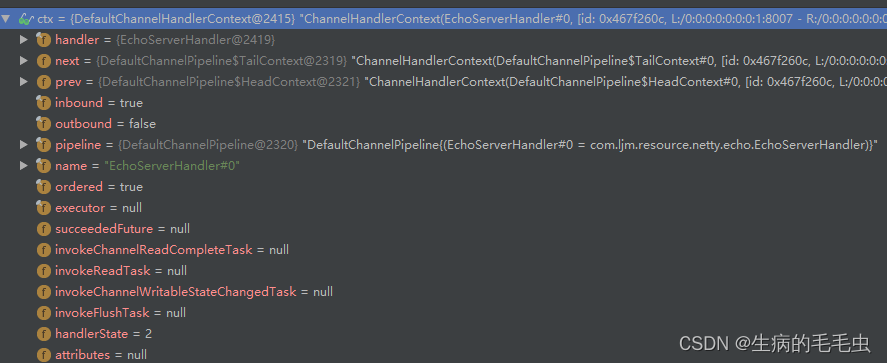
- 我们可以看到当前的handler是自己实现的EchoServerHandl
- 当前状态是入站的状态 inbound = true, outbound = false,Pipeline通过Handler的这个两个字段来找到需要处理 出站/入站 事件的Handler
- 上一个Handler是HeadContext,下一个是TailContext,我们在addLast添加Handler的时候是如下图所示,被添加的Handler是处于Head与Tail之间,这样

- 继续追write方法,如下
private void write(Object msg, boolean flush, ChannelPromise promise) {
AbstractChannelHandlerContext next = findContextOutbound();
final Object m = pipeline.touch(msg, next);
EventExecutor executor = next.executor();
if (executor.inEventLoop()) {
if (flush) {
next.invokeWriteAndFlush(m, promise);
} else {
next.invokeWrite(m, promise);
}
} else {
AbstractWriteTask task;
if (flush) {
task = WriteAndFlushTask.newInstance(next, m, promise);
} else {
task = WriteTask.newInstance(next, m, promise);
}
safeExecute(executor, task, promise, m);
}
}
- 其中关键的方法 findContextOutboumd方法,从名称可以看出,他是在找一个出站的Context,而Context内部就是封装了Handler,也就是需要找到Pipeline双向链表中的出站Handler,如下源码
private AbstractChannelHandlerContext findContextOutbound() {
AbstractChannelHandlerContext ctx = this;
do {
ctx = ctx.prev;
} while (!ctx.outbound);
return ctx;
}
- 需要找到一个处理出站事件的Handler,用do/while循环遍历双向链表,因为当前EchoServerHandler是入站inbound=true,因此他找上一个HeadHandler
- 之后 next.invokeWrite(m, promise); 获取到HeadContext后接着之后的写入
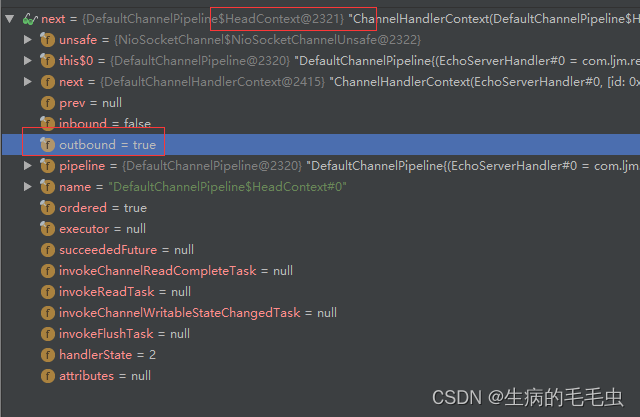
- 整个流程如下,在启动server后
- 通过Http请求发送一个连接事件
- Server收到事件后会在ChannelRead中处理,但是在Server中我们的业务逻辑就是写回一个信息到Socket中,也就是通过write方法写入
- 可见对于当前状态下的server,TailContext是接受到http从socket发过来的事件,从socker到Pipeline的入站
- Head是我们通过调write方法,从Pipeline写数据到Socket是出站。























 1018
1018











 被折叠的 条评论
为什么被折叠?
被折叠的 条评论
为什么被折叠?








